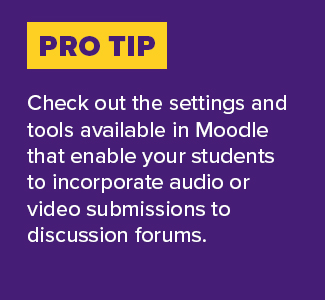Fostering Effective Class Discussions in Asynchronous Settings
 Teaching via live discussion is a tried and true method for many of us. And while
yes, discussions are different when you take them out of a live setting, they can
still be a powerful tool for steering students on their learning path. As their instructor,
you have the ability to foster consistent structure and clearly communicate what you
ask of your students to help them succeed.
Teaching via live discussion is a tried and true method for many of us. And while
yes, discussions are different when you take them out of a live setting, they can
still be a powerful tool for steering students on their learning path. As their instructor,
you have the ability to foster consistent structure and clearly communicate what you
ask of your students to help them succeed.
Start with your end goals in mind and build discussion that reflects these goals.
Is the purpose of the discussion…
...to foster community?
...to make sure they are reading?
...to apply high levels of critical engagement with the content?
Whatever you ask the students to do by way of discussion, hold yourself and your students accountable to it.
This may include one or all the following, or an approach that you personally develop.
- Drop responses directly into the discussion highlighting what’s working.
- In your regular course messages, housekeeping emails and check-ins to the whole class,
pull out key points, recap the broad strokes or share general feedback you have about
what you are reading in their discussions and how they can continue to improve.
- Example: More of X! A little less of Z.
- Send a message to individual students at various times, acknowledging a good point
and encouraging them.
- Example: I see you responded to three different prompts - Keep it up!
“You need to specify not only the what (the prompt) but also the who (to respond to) and the when (it’s due).” —Morton Ann Gernsbacher
Establish a rhythm students can ID and internalize so they can focus on the course content rather than confusion over processes.
 Give time between submissions so students can read what has been shared, prepare a
response, and upload it. For example, in Prof. Jo’s class, every week this happens:
Give time between submissions so students can read what has been shared, prepare a
response, and upload it. For example, in Prof. Jo’s class, every week this happens:
- Due Sunday at 11:55pm: Students submit discussion prompts in writing via the Moodle forum
- Due Tuesday at 11:55pm: Students submit responses to 2-3 different prompts (assigned by Jo in advance, on a rotation)
- Due Thursday at 11:55pm: Student share final thoughts (responses to the discussion responses) on 2–3 prompts of the students’ choice
- Friday: Jo sends a note to the class as a whole recapping some of the highlights from the discussion forum, providing any feedback necessary for the group to keep in mind, and reminds everyone how the discussion topics and content relate to the rest of the course and higher-stakes/culminating assignments. Jo also sends any personal notes to students they want to reach out to for personalized feedback or just to give encouragement.
Don’t be afraid to get meta in your discussions.
- Share with them why you’re incorporating discussion and what skills they are cultivating. Help them clearly see what they will be gaining from the discussion for this course and beyond.
- Show and tell them what makes good discussion by modeling those skills, giving examples, highlighting when you see effective discussion in action and explaining what makes it work.
- With the students, determine the rules of effective discussion. When they are involved in generating the ground rules, they have a higher stake in the course.
- Put students in a position for self-reflection or group analysis of how effectively they are applying those ground rules.
Get right to the point about what you are asking of them.
In a live setting you may be used to opening discussion with a broad question to loosen up the room: “What were your first impressions about Vargas’ book?” In a moodle discussion forum, you don’t have the luxury of a real-time back and forth. Include verbs at the start of your prompts so students realize there are explicit actions associated with what you want. “Explain, in your own words, Vargas’ main argument. Identify in 1-2 sentences what stood out the most to you from the book, and how that fits into Vargas’ main point.
Create prompts that require students to build off of each other in discussion.
There are a variety of models or formulas you can use for this (check out jigsaw prompts, snowball prompts, or the 3-Comment + 1-Question method). The most important thing is that you are giving students direction about how to build on the statements of others in a substantive way. You can also use Bloom’s Taxonomy to help you develop your specific questions. This can help you develop both lower-stakes engagement questions and higher-stakes critical analysis questions.
Remember that discussions can happen without you.
- Assign study buddies and provide specific prompts for how and why to connect with that study buddy. Build study buddy work into the course and give them clear instructions on how to report their discussion work with you (keep them accountable).
- Create small groups for students to engage each other on their own terms with a clearly defined outcome or submission they will share with you or the rest of the class. Consider changing up study groups at different points in the semester if a goal is to have the student connect with the broader class or college community.
- Assigning different roles to students during discussion to help them see beyond “just
talking.” For example:
- Discussants: the prompt creators and respondents
- Analysts: the fact checker, the communication analyst (checking for language, tone and style) and the closer (the one who assesses how effective the discussion was and provides suggestions for improvement next time)
Read more about fostering effective discussions:
- “Five Tips for Improving Discussion Boards,” by Morton Ann Gernsbacher
- “How to Hold a Better Class Discussion,” by Jay Howard
- “How to be a Better Online Teacher”, by Flower Darby
- Read about Bloom’s Taxonomy to help you formulate questions that match your goals.
Building discussion for your C-I Course? Connect with the CxC Team to chat about it!